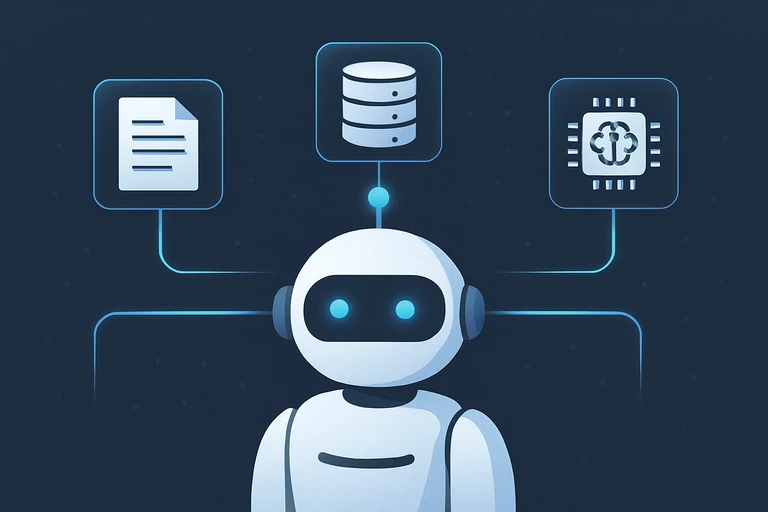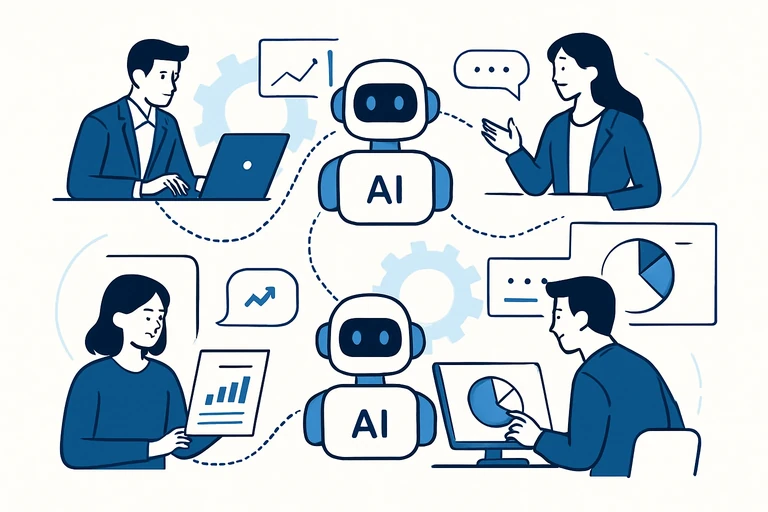The Rise of Autonomous Agents in 2025 explores practical patterns, platforms, and governance conside...

Next-Generation Chatbots: Beyond Canned Answers
Next-generation chatbots move beyond canned responses by combining retrieval-augmented generation, persistent memory, and multimodal capabilities. This guide provides a practical, modular blueprint for building scalable, trustworthy AI assistants that cite sources, leverage internal data, and take action across systems.
Next-Generation Chatbots: Beyond Canned Answers
We are at an inflection point in conversational AI. Traditional chatbots could reliably handle scripted questions, but they often fall short when faced with real-world complexity: up-to-date information, diverse data sources, memory of prior interactions, and the ability to act across different modalities. The next generation of chatbots combines large language models (LLMs) with retrieval-augmented generation (RAG), persistent memory, and multimodal capabilities to deliver contextually accurate, transparent, and human-like interactions. In short: they don’t just answer — they understand context, cite sources, and help users accomplish real tasks.
Why “Canned” Answers Fall Short
Pre-scripted responses are fast to deploy, but they become brittle as data evolves. Customers expect accuracy, personalization, and the ability to reference authoritative documents or policies. When a chatbot cannot access current information or misremembers past conversations, trust erodes and handoffs to human agents rise. This gap has driven a shift toward architectures that couple LLMs with external data sources, rather than relying on training data alone.
Key Capabilities of the Next Generation
- Retrieval-Augmented Generation (RAG): LLMs retrieve relevant documents from internal knowledge bases or the web, then generate responses informed by those sources. RAG helps keep outputs accurate, reduces hallucinations, and enables source attribution.
- Vector Databases and Semantic Search: Data are stored as embeddings in vector stores, enabling fast, meaning-based retrieval that goes beyond exact keyword matches. This is essential for domain-specific knowledge and up-to-date content.
- Long-Term Memory and Contextual Continuity: Modern chatbots remember user preferences and prior conversations, enabling more seamless and personalized interactions over time.
- Multimodal Interaction: Beyond text, next-gen chatbots can process and respond to images, voice, and other data types, enabling richer, more natural conversations.
- Tools and Actionability: They can invoke services, pull data from internal systems, and perform workflows, not just chat.
RAG, vector search, and memory work together to create a robust, auditable, and proactive assistant. This architecture is well-supported by modern AI-native databases and tooling. For example, vector databases like Weaviate provide native RAG capabilities and can be self-hosted for privacy and control, while enabling rapid experimentation with different LLMs.
Architectural Blueprint: A Practical, Scalable Approach
Below is a pragmatic blueprint you can adapt. It emphasizes modularity, security, and measurable outcomes. The goal is to move from “answer templates” to a living system that continuously improves accuracy, relevance, and user experience.
1) Data Foundation and Ingestion
- Map sources: internal documents, policies, product manuals, CRM data, support tickets, and external knowledge (think knowledge bases or public docs).
- Normalize and sanitize data: remove PII, apply data category classifiers, and tag data with metadata (source, last updated date, ownership).
- Prefer structured ingestion for governance: schemas that describe data types, access controls, and retention rules.
In RAG setups, data are converted into embeddings and stored in a vector database for fast similarity search. This is the backbone of contextual, on-demand retrieval.
2) The Retrieval Layer (Vector Store) and RAG Orchestration
- Vectorization: choose an embedding model aligned with your domain (possibly a mix of general-purpose and domain-tuned embeddings).
- Indexing: use a vector store to index the embeddings and support efficient nearest-neighbor search; maintain metadata for post-retrieval filtering.
- Retriever strategy: initial pass with semantic search, followed by re-ranking and, if needed, a keyword or hybrid search for precision.
- Generation: feed the retrieved context together with the user prompt into the LLM, with prompts designed to cite sources and limit hallucinations.
Weaviate, an open-source vector database, provides RAG capabilities and can be deployed self-hosted or in a private cloud, enabling strong data governance and scalability.
3) Memory and Context Management
- Short-term vs. long-term memory: maintain a fresh conversational window while selectively storing meaningful memories (preferences, recurring issues, critical documents referenced in conversations).
- Memory governance: implement rules for what to remember, how long to retain, and how to forget (or obfuscate) when requested by users or by policy.
- Personalization with privacy in mind: allow opt-in memory, with clear consent mechanisms and transparency about data usage.
Long-term memory research explores how to store and recall memories across sessions, which is essential for a coherent, personalized assistant. This is an active area with ongoing advances in the research community.
4) Multimodal Capabilities and Tool Use
- Multimodal input/output: interpret text, image, voice, and possibly video; present results using the most effective modality for the user.
- Tool integration: connect with internal APIs, data stores, and business systems to perform actions (e.g., check inventory, create a ticket, pull policy details).
- Agentic RAG and graph-based reasoning: advanced setups use agents that can reformulate queries, retrieve more data, and build knowledge graphs to support complex reasoning.
RAG-enabled and multimodal pipelines are increasingly common in enterprise AI. Weaviate’s ecosystem and related guides demonstrate how to configure generative queries across multiple modalities and data sources.
5) Governance, Privacy, and Security
- Data minimization and consent: only store and process data necessary for the task, with user consent and clear privacy notices.
- Auditing and attribution: provide source citations for generated content and maintain an auditable trail of data used in responses.
- Security by design: encrypt data at rest and in transit, segment workloads, and enforce strict access controls in your vector store and LLM integrations.
As organizations expand their memory and data access, privacy and ethical considerations become central. Industry coverage highlights privacy concerns and the need for responsible AI practices as these systems evolve.
How to Build and Validate: A Lean, Result-Oriented Roadmap
The goal is to ship value quickly while maintaining guardrails that ensure accuracy and trust. Here is a practical six-stage plan you can adapt.
- Discovery and feasibility: articulate specific business outcomes (e.g., reduce time-to-answer for policy questions, improve first-contact resolution) and define success metrics.
- Data strategy and governance: inventory data sources, classify data sensitivity, and define retention and access policies.
- Prototype with RAG and a vector store: build a minimal end-to-end loop: user input → retrieval → LLM generation → source citations. Use a small, representative data subset first.
- Memory and personalization design: determine what to remember (preferences, recurring issues) and implement a privacy-preserving memory layer with opt-in controls.
- Multimodal extension and tool integration: add image/voice support and connect to internal systems to enable real actions from chat.
- Validation and governance: run A/B tests, monitor hallucination rates, latency, and user satisfaction; establish escalation rules to human agents when needed.
As you scale, consider a modular architecture that lets you swap LLMs, vector stores, and tools without a ground-up rewrite. This flexibility is essential for staying current with rapid AI advancements while preserving governance and compliance.
Concrete Use Cases Across Industries
- Customer support and self-service: a knowledge-backed assistant that cites policies, product documents, and troubleshooting guides, reducing escalation while improving trust.
- Sales enablement: a chat assistant that can pull product specs, pricing, and competitive data to answer questions during live demos or chat sessions.
- IT and security operations: an internal bot that triages incidents by retrieving runbooks and ticket histories, and can open tickets or update statuses in integration with ITSM tools.
- HR and policy compliance: a dispatcher that can summarize handbook sections, retrieve benefits information, and cite the source in responses for compliance-critical questions.
- Knowledge work and R&D: engineers and researchers querying internal documents, whitepapers, and dashboards with precise citations and contextual summaries.
The common thread is a shift from generic answers to a guided, verifiable, and task-oriented experience that helps users achieve measurable outcomes.
Measuring Success: What to Track
- Accuracy and grounding: rate of citations, and user validation of correctness; track hallucination rate and confidence calibration.
- Responsiveness and reliability: mean latency, uptime, and throughput under load.
- Engagement and outcomes: time-to-answer, first-contact resolution (FCR), and conversion metrics tied to the bot’s tasks.
- Privacy and trust indicators: consent uptake, opt-out rates, and user-reported comfort with memory features.
Balancing these metrics helps ensure the system not only answers correctly, but also respects user privacy and builds long-term trust.
Best Practices and Pitfalls to Avoid
- Start simple, then expand: begin with a small, high-value data subset and iterate quickly before expanding data sources or capabilities.
- Design for transparency: clearly indicate when information is retrieved and cite sources in the response; avoid presenting retrieved content as your own invention.
- Guard memory with consent: implement explicit user controls for what is stored and for how long, with easy forget requests.
- Guardrails against sensitive data: implement automated redaction or access controls for PII and sensitive information.
- Plan for governance: maintain policy docs, data lineage, and a decision log for model behavior and data usage.
Following these practices reduces risk, accelerates adoption, and supports a sustainable AI program aligned with business goals and ethics.
Closing Thoughts: The Multek Advantage
At Multek, we help organizations design and deploy next-generation chatbots with a strong emphasis on security, privacy, and ROI. Our approach blends RAG, memory, and multimodal interfaces to create intelligent assistants that actually move the business forward — not just chat. If you’re ready to explore a practical, scalable path to AI-powered transformation, we can tailor an architecture, a data strategy, and a phased rollout that aligns with your regulatory requirements and customer expectations.


